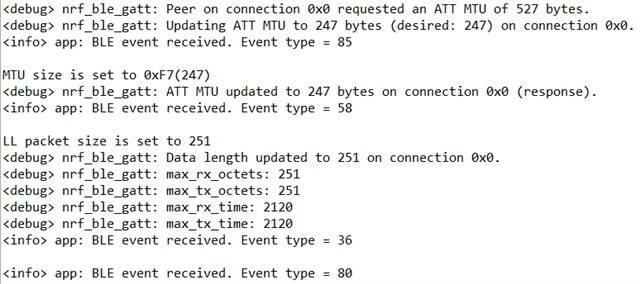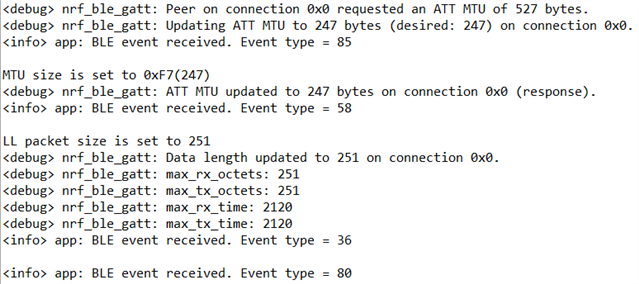.Hi Nordic Support team,
I'm using NRF52832, SoftDevice S132, SDK version is nRF5_SDK_17.1.0_ddde560.
I want to transmit 9 bytes of data collected from an I2C sensor every 2.5ms via BLE. The sensor has an internal buffer so I can queue up to 288 bytes (80ms from empty to full sensor buffer). However, I2C can only receive 255 bytes per queue, so I only collect data from the sensor every 60ms, because for 60ms, the sensor produces 216 bytes of data and it is within 1 MTU packet ( configure it to be 247 bytes per MTU). That means I will send 1 MTU every 60ms. That means I only need a connection interval of 60ms. Am I correct?
In my BLE structure, I also have another different characteristic that reports the device temperature (takes only 2 bytes) every 10 seconds (yes, second not milliseconds). However, from my experiment, 60ms cannot keep up with this data rate from both characteristics. Do I misunderstand anything? Should I use the connection event extension length?
Here are my BLE parameters: NRF_SDH_BLE_GAP_EVENT_LENGTH is 6. TX queue length is 1. Min connection interval = Max connection interval = 60ms. Save lantecy is 4.
I also have tried to increase the TX queue length to 18. Set Min connection interval = 30ms, Max connection interval = 120ms, enable Connection Event Length Extension by the following code right after ble_advertising_init. However, I still occasionally get NRF_ERROR_RESOURCES from sd_ble_gatts_value_set(p_cus->conn_handle, p_cus->data_char_handles.value_handle, &gatts_value);
What I am trying to do is optimize power consumption while also ensuring absolutely NO data loss via BLE transfer.
// Connection Event Length Extension ble_opt_t opt; memset(&opt, 0x00, sizeof(opt)); opt.common_opt.conn_evt_ext.enable = true; err_code = sd_ble_opt_set(BLE_COMMON_OPT_CONN_EVT_EXT, &opt); APP_ERROR_CHECK(err_code);
Please let me know if I do anything wrong.
Best regards,
Xander





